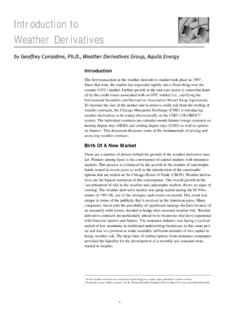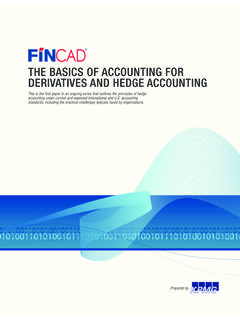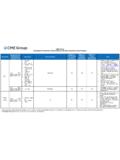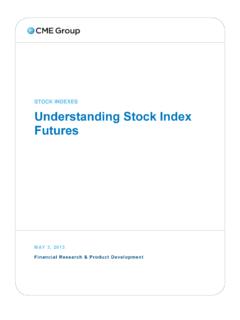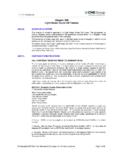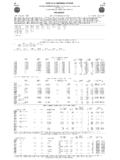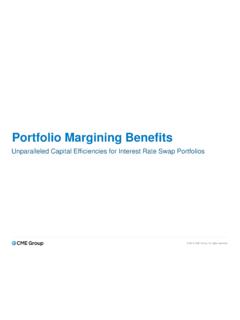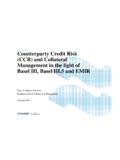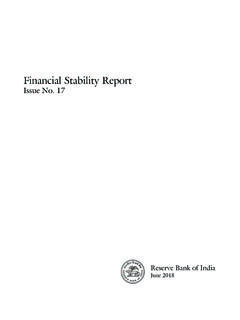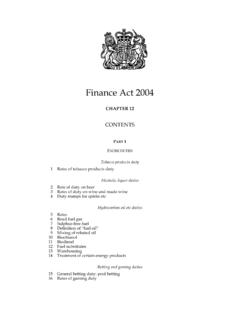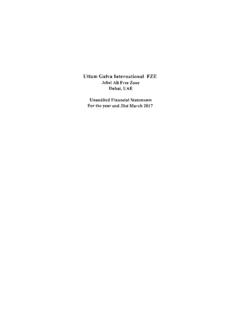Transcription of BASICS OF CREDIT VALUE ADJUSTMENTS AND …
1 BASICS OF CREDIT VALUE ADJUSTMENTS . AND implications FOR THE ASSESSMENT. OF HEDGE EFFECTIVENESS. This is the third paper in an ongoing series that outlines the principles of hedge accounting under current and expected International and accounting standards, including the practical challenges typically faced by organizations. Prepared by BASICS of CREDIT VALUE ADJUSTMENTS and implications for the Assessment of Hedge Effectiveness Under current and International accounting standards, the fair market VALUE for Over-the-Counter (OTC) derivatives should reflect the CREDIT quality of the derivative instrument, which is generally cap- tured through any applicable CREDIT VALUE adjustment (CVA). CVA represents an adjustment made to the VALUE of the derivative to account for the CREDIT risk of the counterparty to the instrument.
2 BRIEF HISTORY OF THE CREDIT VALUE adjustment . The concept of default and its painful financial repercussions have been well established in history and understood by investors. There have been many examples, including Sovereign entities such as Russia (1998) and Argentina (2001), and Corporates such as Long Term Capital Management (1998), WorldCom Inc. (2002), and Lehman Brothers (2008). These types of default events and the subsequent financial fall-out lead to the evolution and development of CREDIT risk management. Much of the research in CREDIT risk management was focused around the identification and quantification of CREDIT risk, particularly Counterparty CREDIT Risk (CCR) which is the exposure to loss as a result of a counterparty failing to meet its contractual obligations due to default.
3 While CCR was conceptually understood, for years it was broad industry practice to VALUE OTC derivative instruments without considering CCR largely due to the mistaken belief that large derivative counterparties were too big to fail or that it would be highly unlikely that counterparties would default. It was not until the financial crisis in 2007/2008 that market participants realized the cold reality that no entity was immune from default risk and began to incorporate the VALUE of CCR and price into the cost of derivative instruments, especially at the deal level. CHALLENGES AROUND COUNTERPARTY CREDIT RISK. A derivative instrument is a contract between two counterparties whose price is dependent upon or derived from one or more underlying variables. Derivatives can be classified as either a unilateral derivative or as a bilateral derivative depending on the nature of the payoff of the instrument.
4 For the holder of a unilateral derivative instrument, like an investor in a purchased option position for example, the exposure is to any loss that would occur if the counterparty were to default. The loss for the investor would be measured as approximately the fair VALUE of the instrument (less any recoveries). at the time of default. The counterparty's obligation and exposure arising from its sale of the option to the investor remains the same whether or not the investor defaults. Any money owed to the investor would still be owed to the investor's estate, even in the event of default or bankruptcy by the investor. Bilateral instruments, such as interest rate swaps and foreign exchange forward contracts, are more complex than unilateral instruments since there is two-way or bilateral counterparty risk as both the investor and the counterparty are exposed to each other.
5 In the case of the swap, for example, one counterparty is simultaneously long the receiving leg and short the paying leg, while the other counterparty is simultaneously short the receiving leg and long the paying leg. The VALUE of the swap is the net VALUE of the two legs and, in the event of default, the recovery is on the net market VALUE of the swap. 2. BASICS of CREDIT VALUE ADJUSTMENTS and implications for the Assessment of Hedge Effectiveness The challenge with bilateral instruments is that, at any given valuation measurement date, they may be in either an asset or liability position or have no VALUE at all. For this reason, each counterparty is potentially exposed to the other. For example, Counterparty A, in an in-the-money positive asset position today, is exposed to its Counterparty B because, in the event of default, Counterparty B would owe it the positive market VALUE of the swap.
6 On the other hand, even Counterparty B, in the out-of- the-money negative liability position, has potential CREDIT exposure to Counterparty A. This is because over time, that same swap may convert to an asset position. Even for a swap with zero net VALUE , counterparties are exposed to one another because the derivative has the potential to change to an asset or liability position anytime. This counterparty CREDIT exposure or default risk may be mitigated through the netting and offset provisions of the underlying International Swap Dealers Association (ISDA) master agreement (typically an entity must first enter into an ISDA master agreement with a bank or dealer prior to transacting derivative instruments), which permits offsetting negative or liability positions against positive or asset positions with a specific counterparty in the event of default.
7 There may also be an ISDA CREDIT Support Annex (CSA) that provides for the posting of collateral to cover all or a portion of the net market VALUE of the position to limit the exposure. WHAT IS A CREDIT valuation adjustment ? CVA is the price of the default risk for a derivative or portfolio of derivatives with a particular counterparty considering the effect of offsetting collateral. In other words, CVA is the price one would pay to hedge the derivative instrument or portfolio of instruments' specific counterparty CREDIT risk. CVA is calculated as the difference between the risk free VALUE and the true risk-adjusted VALUE . In most cases, CVA reduces the mark-to-market VALUE of an asset or a liability by the CVA's amount. CVA was introduced as an enhancement to fair VALUE accounting around 2007/2008, coinciding with the advent of the CREDIT crisis.
8 It made an entrance as a new requirement focusing on quantifying the price of CCR just at the time when CCR and spreads attributable to those risks escalated to unprecedented high levels. CVA has attracted much attention among derivative market participants and their regulators alike as most major market participants already measure CVA in their accounting statements and integrate CVA into deal pricing. CVA valuation METHODOLOGIES. While CVA valuation methodologies are well advanced, they are still not standardized and may vary amongst market participants, ranging from relatively simple to highly complex methodologies that are driven largely by the sophistication and resources available to the market participant. Depending on the particular market participant, CVA can be significant, particularly for large financial institutions that are highly active in the derivative markets.
9 In order to determine CVA, organizations start by quantifying and measuring net counterparty CREDIT exposures (typically using specialized software). The next step is then to price the CREDIT risk of those exposures using the contractual terms and conditions of the derivative instrument or portfolio and 3. BASICS of CREDIT VALUE ADJUSTMENTS and implications for the Assessment of Hedge Effectiveness market inputs such as interest rates, foreign exchange rates, CREDIT default swap (CDS) spreads and other relevant variables. Determining which CVA valuation methodology to adopt is often driven by the organization's sophistication, technical ability and resource constraints. The simplest approach involves calculating the current mark-to-market VALUE of the derivative and then repeating the calculation by adjusting the discount rates, in a discounted cash flow framework, by the counterparty's CREDIT spread when the exposure is to the counterparty ( the derivative is in-the-money or an asset) or one's own CREDIT spread if the counterparty is exposed to the entity ( the derivative is out-of-the-money or a liability).
10 The difference between the two resulting present values is the CVA amount. A more robust approach relies on a swaption type valuation approach to estimate the contingent replacement VALUE of the derivative using the counterparty's respective CREDIT spread. This approach requires more sophisticated knowledge of derivative valuations and access to more specific market data such as interest rate volatility surfaces. More advanced approaches involve simulation modeling of market risk factors and risk factor scenarios and then revaluing each derivative using, for example, thousands of simulation scenarios by a hundred time steps. The resulting matrix of simulations by scenario and time steps is then aggregated to generate an expected exposure profile for each netting counterparty. A collateralized expected exposure profile is then derived by adjusting each counterparty's expected exposure profile to account for the receiving and posting of collateral as applicable.
